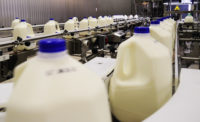Following is a summary from the USDA’s Dairy Market News for the week of April 21 to 25. Download the full report, which includes an analysis of cheese, cream and dairy ingredient production.
Milk production continues to see increases in the Northeast
Milk production is showing increases throughout the East with greening forage, improved cow comfort, and cow and heifer calving. Production volumes in the Southeast and Mid-Atlantic are increasing. Declines in Class I demand led to reductions in most bottlers' fluid milk intakes. Contacts note that milk haulers are experiencing unloading delays as surplus milk supplies look to clear at regional manufacturing plants. Milk production continues to see increases in the Northeast region, with manufacturing volumes reported as heavy at most balancing plants. Milk production in Florida is steady.
Midwest milk producers say the flush is beginning
Milk producers are indicating the flush is beginning. Some farmers increased supplements to help make up for lower forage energy levels. Extra milk supplies in the Mideast section of the region were relocated to northern plants. Spot loads of milk are becoming readily available, ranging from $2.00 under to $1.25 over Class. Sales of bottling are steady to lower. Milk processors skimmed additional amounts over the holiday weekend. Class II orders are steady to higher with notable increases in cultured products and whipping cream. Butter churns took greater volumes of cream over the weekend and ice cream makers are actively purchasing supplies as well.
In Arizona, fluid milk sales are unchanged
California farm milk production has plateaued according to milk handlers throughout the state. Weather remains comfortable for dairy herds. Class 1 demand was higher at the beginning of the week as bottlers ordered more heavily to restock consumer outlets. Demand for condensed skim and cream from Class 3 operations is ramping up steadily.
Milk production in New Mexico continues to add farm milk loads to the state weekly totals, although handlers report the rate of increase is slowing. The number of weekend holdover loads staged at various locations was higher compared to non-holiday weekends as several smaller manufacturing operations were closed from mid-Friday – Monday. Fluid orders are higher as bottlers restock grocery and convenience store outlets.
Arizona milk handlers report farm pickup volumes are mostly steady. Daytime temperatures are warming seasonally, but nighttime temperatures are offering restorative cool down periods to dairy herds. Fluid milk sales are unchanged. Cream demand is steady from local and out-of-state end users. However, some cream is being held back for upcoming churning.


